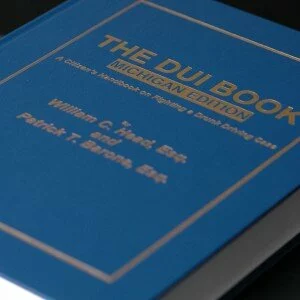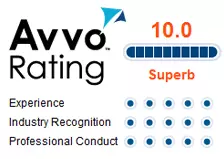Find Michigan DUI Lawyer | DUI Breath Testing

DUI Book Photo
This topic is covered in Chapter 10 of the Michigan DUI Book. What follows is a small excerpt from that chapter.
Chapter 10 – Understanding Breath, Blood, Urine, Saliva or other Forensic Testing and Your OWI Case.
10.0. Purpose of this chapter. As a part the investigation of your OWI case, it is almost certain that the police obtained a sample of your blood, breath or urine for a scientific evaluation, or that you refused to provide the same. If you refused, this chapter is otherwise irrelevant unless a warrant was obtained and a biologic sample was thereafter forced from you. Either way, if you have gone through one of these chemical tests, then this chapter will help you understand the scientific underpinnings of these tests, as well as their strengths and weaknesses.
10.1. Breath test – most common form of testing. There are two general types of breath tests you may have taken in your OWI case, a roadside or portable field test and a more accurate and reliable test on a machine back at the jail or station house. The field test obtained from the handheld device is like any other field sobriety evaluation, that is, an officer can use it simply to determine the presence or absence of alcohol in your system and to a lesser extent, your possible level of alcohol impairment. Michigan has specifically authorized the use of these devices as a part of their OWI law.[1] Any numerical values obtained from the portable device at the time of your testing are typically legally irrelevant except when the court evaluates the propriety of your arrest. The portable test result is also admissible by the prosecutor when a “rising blood alcohol” defense is claimed by the defense. In this limited instance, the prosecutor can seek to have the portable breath test admitted into evidence to show that your blood alcohol level was higher at the time of your driving.[2]
The second breath test you may have typically taken is the more sophisticated and scientifically accurate machine used at the police station or at the jail. Michigan exclusively uses a device for this purpose that goes by the trade name “DataMaster.” This is a table-top machine, and produced for you and the officer a print-out of the results after the testing. The rest of this subsection addresses this table top machine, as these are the results that can be used in court as evidence by the prosecutor in order to attempt to gain a conviction for OWI based on the theory of UBAL, specifically that your actual blood alcohol level at the time of your driving was unlawful.
10.1.1. One sample collected or two for there to be a valid test? In Michigan, the administrative rules applicable to breath tests require the police to request and obtain two samples of your breath. However, one sample is sufficient to satisfy the law, and the courts have interpreted this administrative rule such that only one sample is truly required.[3] If two breath samples are obtained and tested, then the results must be close enough to one another to demonstrate through consistency that the machine is working properly.[4]
10.1.2. If two samples, how closely must the results (numbers) be to each other to constitute a valid test? For the test results of either of the breath samples to be considered accurate enough to be used against you, Michigan requires that these results be within a given and allowable range of error or both results might be thrown out. This allowable range of error varies depending on the specific results of each test.[5] Generally speaking, the higher the results, the more variation between them allowed.
10.1.3. Regulations or statutes requiring testing officer to follow specified protocol. Because scientific breath testing occurs so frequently and has been so competitively litigated, the State of Michigan has promulgated specific protocols or “administrative rules” with regard to performing this testing. If you did take a State administered breath test, in light of your presumption of innocence, the prosecution must typically prove that at the time of your test this particular equipment was in working order, was properly maintained and that the test was administered in a proper fashion, typically according to their protocol.[6] Ostensibly, these administrative rules were designed to assure and control the quality of the results obtained, but were also drafted in consultation the prosecutors as to what is required for such an arrest to be successfully followed by a conviction.
The best OWI specialists know these administrative rules for the breath testing, and more importantly, the reasons behind the steps in the rules. If the administrative rules for your breath test were not followed, this may imply to the court that there is a problem with either the arrest or with the evidence. While the administrative rules are used partly to protect the police officers during their investigation of your case, a failure to follow these rules may result in the dismissal of the UBAL charge or possibly an outright win at trial.
10.1.4. Manner of blowing can alter final results. The manner in which you blow into the DataMaster might effect your breath test result in one of several different ways.[7] First, if you attempted to comply with the breath test, but there was a problem with the plastic mouthpiece, this might cause your machine to malfunction. The same might be true if you “overblow” (blow too hard or with too much air). A malfunction in the pressure switch may cause a false reading. If the officer does not realize what is causing the problem, he or she might believe that you have refused the test by non-compliance. On the other hand, if you attempt to blow five times within the two minute time-out period, the machine will determine that you have refused the test. This is called a “technical” refusal.
Next, you can hyperventilate by crying. As the air is circulating into and out of your lungs too quickly, the results of the amount of alcohol it reads in your breath does not accurately reflect what is in your blood stream. In addition, if you took the test while seated and leaning forward, this position may have caused a reflux of some of your stomach contents, including any alcohol in the stomach gases or free in your stomach. Because the machine automatically considers a ratio of alcohol in your breath verses your blood alcohol level, liquid alcohol or alcohol in this stomach gas can falsely and markedly increase the results.
Many more defenses appear in The DUI Book. This topic is also covered in detail in the two volume treatise entitled Defending Drinking Drivers, which is available for purchase on-line.
Get a FREE confidential CASE EVALUATION on your Michigan OWI/OWVI/DUI by calling (248) 306-9159 , or filling out this consultation request form. Call now, there’s no obligation!
[1]M.C.L.A. 257.625a(2).
[2]M.C.L.A. 257.625a(2)(b).
[3]People v. Fosnaugh, 248 Mich.App. 444, 639 N.W.2d 587 (2001).
[4]Mich. Admin. Code R. 325.2655(f).
[5]Mich. Admin. Code R. 325.2655 – table – from 0.01 to 0.04.
[6]People v. Willis, 180 Mich.App. 31, 446 N.W.2d 562 (1989).
[7]Head, William C., The Georgia DUI Trial Practice Manual (2005 Ed.), § 5.1.2.5.



